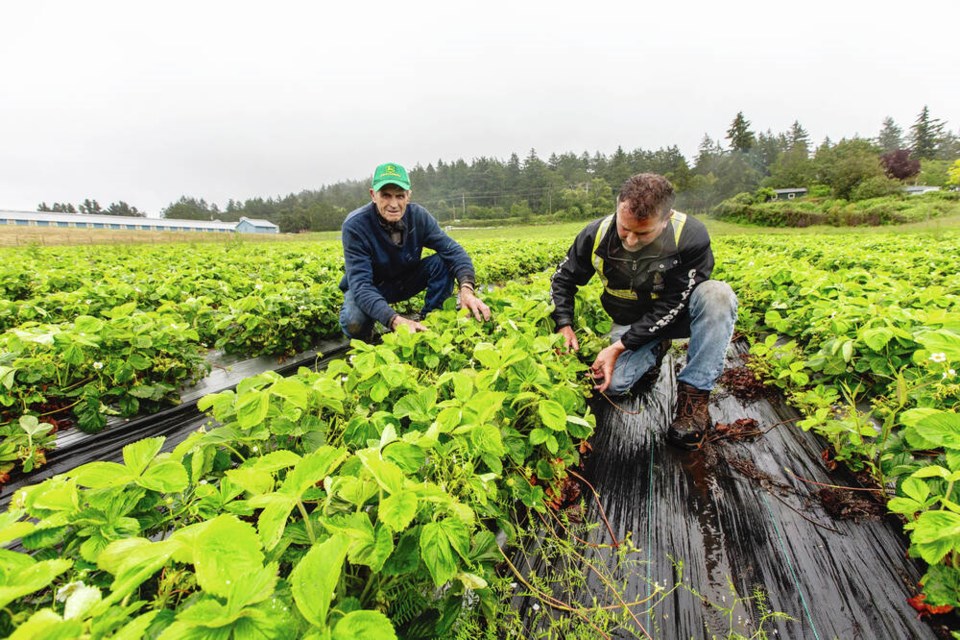In any other year, the fields in Saanich and the Peninsula would be filled with strawberry pickers.
Farmers could at least start paying some bills on record-high input costs. Seeds, fuel and fertilizers have doubled from a year ago, and wages continue to escalate.
But the rain pounded down again on Thursday, and temperatures remained low, as June’s main cash crop sits green, awaiting an elusive heat that turns berries bright red, sweet and delicious.
It has been one of the latest planting seasons in memory for a lot of farmers on Vancouver Island, including Terry Michell whose family has supplied wholesalers and Island grocers with fresh fruit and vegetables for decades.
“I’ve never seen a spring like this,” Michell said. “From April to June. it’s been wet, cold. I’ve talked to a lot of farmers and they are saying the same.”
The south coast of the Island is getting hit again, with between 60 and 70 mm of rain expected through to Saturday, according to Environment Canada.
As the rain fell at Galey Farms in Saanich, Rob Galey and his farmers from Mexico pulled weeds and were on standby with shovels, prepared to divert water from already saturated fields. Many workers were given the day off.
Last year at this time, the strawberry harvest was in full swing and the farm gates and grocery stores were overflowing.
“We’re at least three weeks behind — and that’s the entire growing season,” said Rob Galley, who has half a million strawberry plants in the Blenkinsop Valley.
That means corn, squash potatoes, carrots and other vegetables are going to be later than usual.
The missing ingredient is heat, said Galey.
With overnight and daytime temperatures stubbornly low and days of sunshine rare this spring, lower than usual soil temperatures have delayed seed germination and the ripening of berry fruits.
“The good news is the crop looks fantastic,” said Galey.
The plants are lush and thick and ladened with green berries that now need sun. “There’s a ton of fruit,” said Galey. “This year we could see a spike of strawberries all coming at once, and [with different varieties] it will be broad season. We’re hoping to have strawberries through to October.”
Galey has experienced two years of extremes — a heat dome last June that burned his fields and now a soggy June that’s delaying the crops.
“I’ve been in this business for 30 years and I’ve never seen such opposite extremes over the course of a year,” he said. “Never in my life have I ever worn a toque during May or June. That tells you a lot — no wonder the plants aren’t producing.”
At Silver Rill Farms in central Saanich, much of the Fox family’s corn crop is under heat-retaining covers, which raises the temperature of the soil but allows rain and sunlight through.
Clay Fox said about 30 acres are covered, which has helped the plants to reach about three feet high and the corn to start “tasseling” on Thursday.
“Because it’s so cool, we’ve been using [covers] later this year,” said Fox. “It’s not a normal year.”
In previous years, Silver Rill usually has 70 acres already seeded, but this year only 50 acres are done because the fields have been too wet.
Delays in planting and growth could mean Silver Rill corn will be about two weeks behind, and available in the second or third week in July, said Fox.
The family will open its farm gate this weekend to sell other produce, including sweet and coloured carrots as well as beets.
Fox said the family is considering resuming its presence at local farm markets around the region, worrying that high gas prices might cause consumers to think twice about visiting the farm just to buy corn.
Galey said it’s a difficult period for farmers, who have been spending a lot of money on fuel, fertilizers and wages with no income coming in.
B.C. hiked its minimum wage to $15.65 an hour, up 45 cents, on June 1. Fertilizers leapt from $1,000 a tonne to $2,000. Fuel prices have also jumped nearly 60 cents a litre since last June, “so we’re getting killed here,” said Galey.
“As a farmer, all you can do is your very best and try not to get depressed about it.”
Michell said local farmers’ prices will move higher, just as they have for imported produce at grocery stores.
Statistics Canada said Canadians paid 9.7 per cent more for food in April than a year prior as the cost of living continues to rise at the fastest pace in decades. Inflation rose at a 6.8 per cent annual pace in April, a new 31-year high, and food was a main driver.
Michell Farms supplies the Island’s three main wholesalers, which sell the produce to major grocers such as Thrifty Foods, Fairway markets, Country Grocer, Red Barn Markets and the Root Cellar.
“We always hope people look for local produce in stores,” said Michell. “About 90 per cent of what we spend gets put back into the community.”



